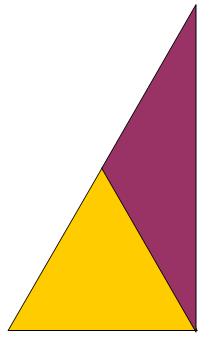Skip over navigation
Can you think of a reason why the yellow and purple triangles are equal in area ?

If the side length of the yellow triangle is taken as the unit for length, what length is the third side of the purple isosceles triangles ?
Or search by topic
Number and algebra
Geometry and measure
Probability and statistics
Working mathematically
Advanced mathematics
For younger learners
The Square Hole
Age 14 to 16
Challenge Level 





- Problem
- Getting Started
- Student Solutions
- Teachers' Resources
Can you think of a reason why the yellow and purple triangles are equal in area ?
If the side length of the yellow triangle is taken as the unit for length, what length is the third side of the purple isosceles triangles ?

